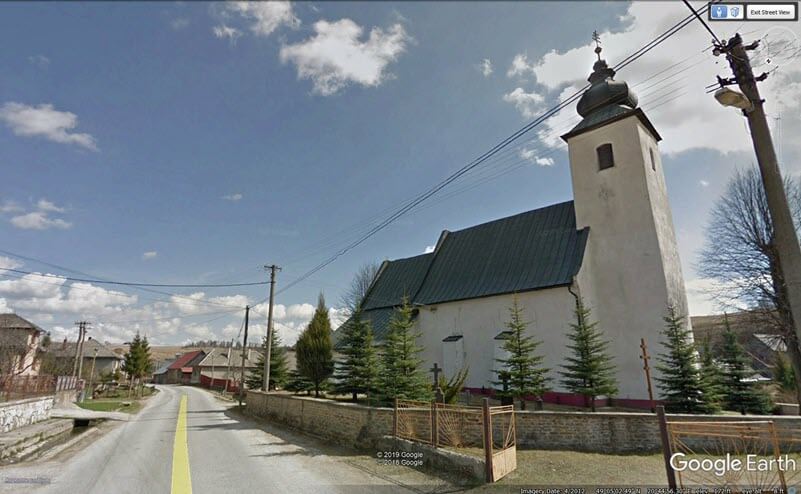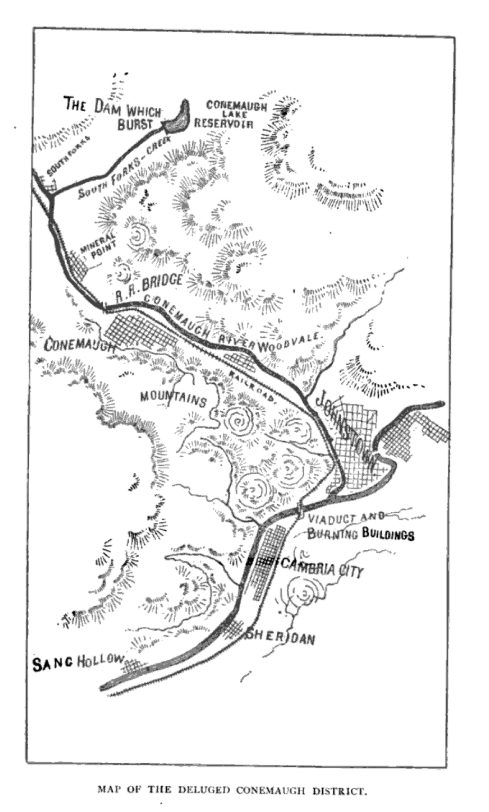by Diahan Southard | May 11, 2016 | 01 What's New, House History
A “house history” can tell you more about the house you live in–or your ancestor’s home. Here’s how.
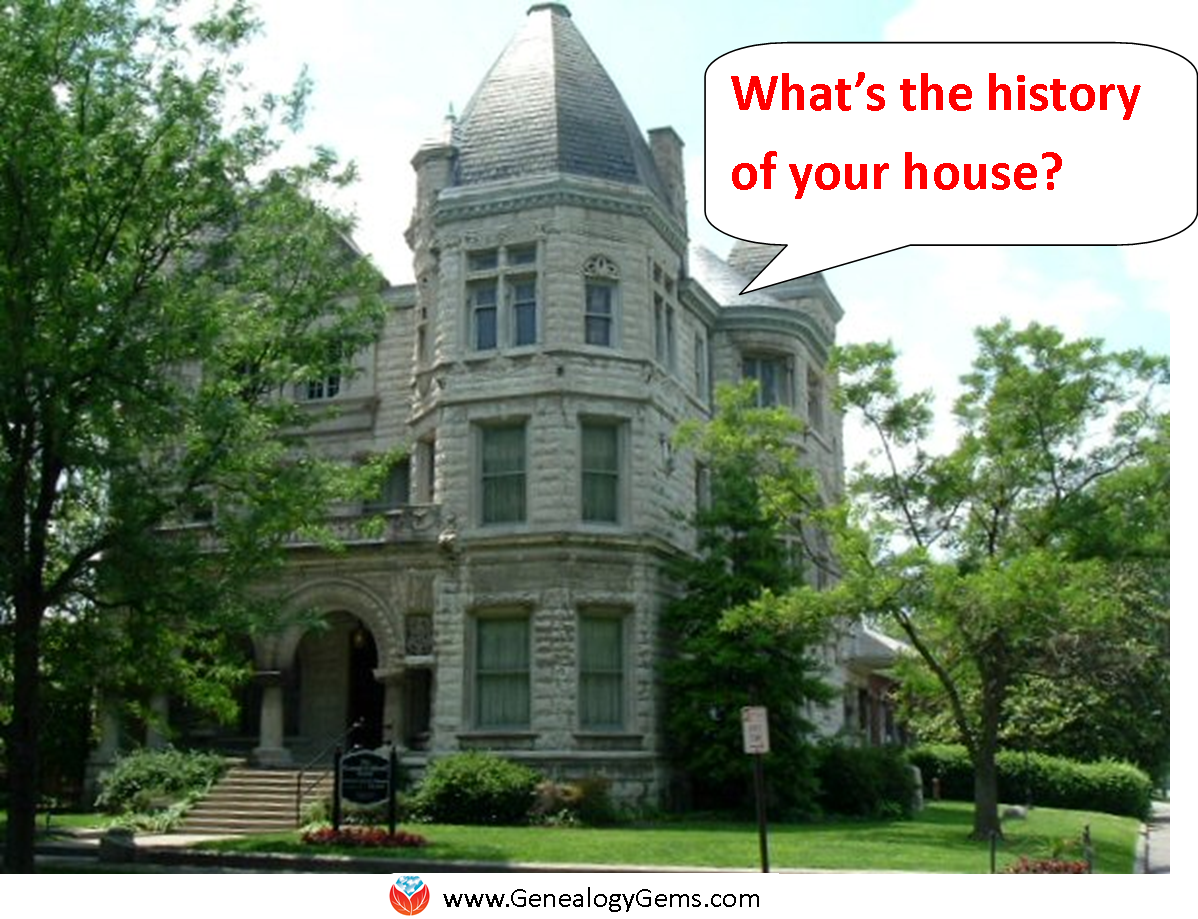
Are you curious about the history of the house you live in, or would you like to trace the history of a family property? The online article “How to Research Your Home’s Past” by Charity Vogel has some great ideas. It’s not written for family historians, but I like some of the ideas it suggests:
1. Pull a full history of home ownership off your deed. (Historical deeds may not have these. But each deed does represent a link in the chain of property ownership: you should be able to move forward and backward in time in deed records until you’ve listed all owners.)
2. Use census records to learn more about other folks who lived in your home. Remember you’ll be able to see how many people lived there, and, for some census years, whether they owned or rented.
3. Watch for unusual patterns of ownership. For example, a deed showed sisters co-owning a home in the 1930s. Additional research showed that the sisters were nurses and ran the house as a community hospital. How cool is that to know about a house?
4. If it was a grand or unusual home, see whether the newspapers covered its construction. The author of the article found an 1898 article that detailed the entire five-month building process of her house!
Last year I shared an applicable research strategy in my blog post A Shocking Family Secret, and 3 Powerful Newspaper Research Tips about researching our ancestors and where they lived. By searching on their home address, and not including their name, you can uncover “a kind of house history set of search results, revealing who lived there before, descriptions of the home and its contents and who moved in after your ancestors left. In my case, I located an article about the Cooke home (by the address) being up for sale several years before they owned it. That article included a fairly detailed description of the property. The final article found in the British newspapers was also found only by address (as the Cooke name wasn’t mentioned) and it detailed the contents of their household up for sale. The auction was held in preparation for their move to Canada.” (Click here to learn more about finding your family history in newspapers.)
While looking for more on this topic, I came across a great newspaper article about three researchers who specialize in house histories. They said that in addition to the personal satisfaction of knowing about a family home, “A bit of history and story makes it much easier to sell: it attracts a certain buyer.”
Here are a few more helpful resources, if you’d like to research your house history:
More House History Gems: Researching a Family Residence
Ancestral Landmark Discovery with Google Earth
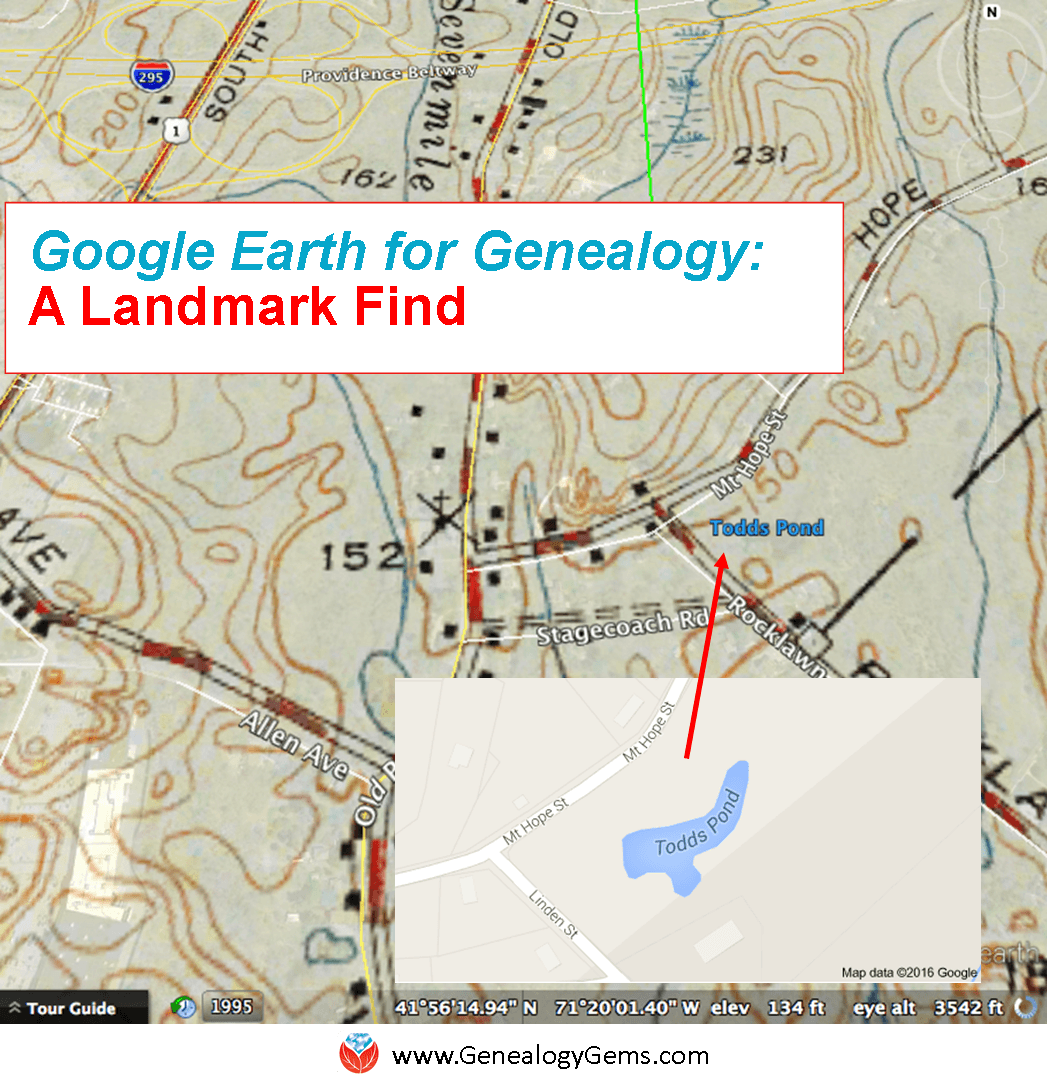
How to Find a Family Address: 4 Steps to Using Google Earth for Genealogy
Was This My Ancestor’s Neighborhood?
by Lisa Cooke | Sep 18, 2017 | 01 What's New, Conferences
Do you want to revitalize your genealogy energy, boost your online research skills, and better organize your many family history discoveries? Join Lisa Louise Cooke at the “Reinvigorate Your Research” all-day seminar in Denver, Colorado, hosted by the Jewish Genealogical Society of Colorado.
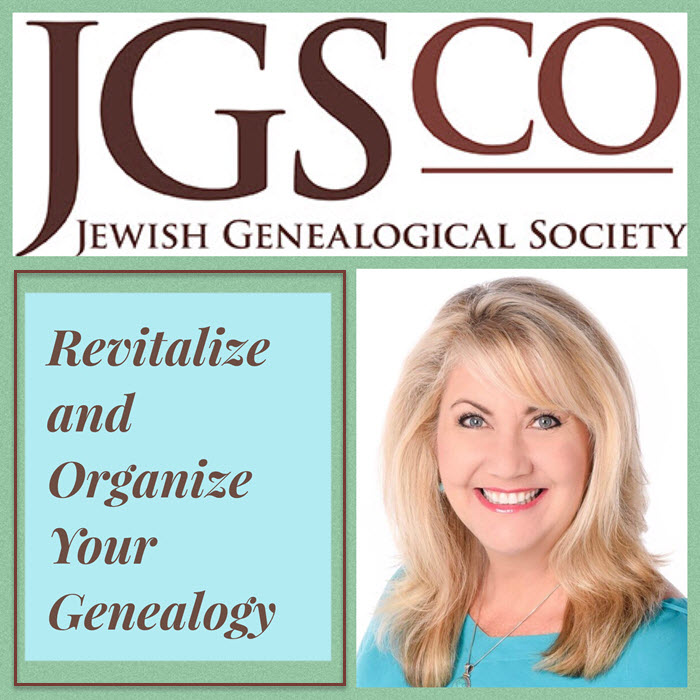
Genealogists seem to face some universal challenges. Like, how to research online more effectively and efficiently. How to organize what you find (especially when discoveries are spread across various websites and in paper files). Knowing which technology tools to invest in, and how to master them. Genealogy and technology expert Lisa Louise Cooke can help you with all these challenges–in person, in fact, at this upcoming all-day event in Denver, Colorado.
Organize Your Genealogy, Revitalize Your Research
Here’s what you’ll want to know about this event:
What: “Reinvigorate Your Research with Lisa Louise Cooke:” Annual All-Day Seminar by JGSCO
Where: Jewish Community Center, Social Hall, 350 S. Dahlia St, Denver
When: Sunday, October 15, 9:00 am – 3:30 pm (doors open at 8:00 am for registration)
Hosted by: Jewish Genealogical Society of Colorado
Registration: Register online by October 9, 2017
BONUS: Cost of admission ($20 members/$35 nonmembers) includes continental-style breakfast, snacks, and a Kosher buffet-style lunch.
Lisa’s host, The Jewish Genealogical Society of Colorado, has chosen a fantastic lineup of Lisa’s lectures that really do hit on all those pain points we have. Here’s what classes you’ll get to enjoy all day on Sunday, October 15:

How to Organize All this Genealogy Stuff! Save yourself future frustration and disappointment by putting a solid genealogy organizational plan in place for all the types of items that will be coming your way.
- Organizing All This Paper! The Physical Items Organization System
- Organizing All That Genealogical Data! The Family Tree Data Organization System
- Organizing All These Digital Files! The Digital Organization System
- Organizing All that Web Information! The Online Notetaking System
Google Search and Google Books: Tools for Every Day. Discover Google search tools and new ways for using them to solve the genealogical challenges you face. Learn the secrets of getting more than you ever imagined from the largest online collection of digitized books–Google Books. With 25 million books, many of which are digitized and fully searchable, Google Books should be the first place to which you turn as you climb your family tree. Learn how to make the most of this goldmine chock full of historical data with little-known techniques.
Time Travel with Google Earth. Get ready to experience old historic maps, genealogical records, images, and videos coming together to create stunning time travel experiences in the free Google Earth program. We’ll incorporate automated changing boundaries, and uncover historic maps that are built right into Google Earth. Tell time travel stories that will truly excite your non-genealogist relatives! You’ve never seen anything like this class!
Future Technology and Genealogy: 5 Strategies You Need. Envision your genealogy as technology speeds ahead into the future. There are five key strategies that you can employ right now that will make the ride easier and the results more exciting than ever. Discover the paradigm shift that will make it easy to find the right technology for your needs and learn how to capitalize on how technology is changing the flow of information.
Bring Lisa Home with You
 I’m sorry if you’ll miss this event–Lisa’s seminar attendees always leave with a new list of strategies they can’t wait to try. (I’ve actually seen people sneak onto their devices during her presentations and start trying the apps, search strategies, and tools she’s talking about. It’s like they can’t wait after she shows them what’s possible.)
I’m sorry if you’ll miss this event–Lisa’s seminar attendees always leave with a new list of strategies they can’t wait to try. (I’ve actually seen people sneak onto their devices during her presentations and start trying the apps, search strategies, and tools she’s talking about. It’s like they can’t wait after she shows them what’s possible.)
You can bring Lisa home with an annual Genealogy Gems Premium membership. Premium members have exclusive access to a packed archive of video classes–including a new class on Google Books and an entire series to help you organize your genealogy “stuff.” You also get ongoing tips and inspiration in her monthly Premium Podcast (and access to all past episodes). It’s the most affordable and consistently high-quality, tech-forward genealogy education around. And you can start trying her tips any time you like.
by Lisa Cooke | Aug 20, 2016 | 01 What's New, DNA, Societies |

The Daughters of the American Revolution (DAR) accepts limited DNA evidence to prove descent from a Revolutionary War veteran. In my opinion, the DAR DNA policy is a little too limited. Here’s why–and what you can do.
Membership to the Daughters of the American Revolution (DAR) has been a holy grail for U.S. genealogists for 125 years. With its requirement of proof of a “lineal bloodline descendant from an ancestor who aided in achieving American independence” in three categories: birth, marriage, and death, as well as proof of Revolutionary War Service, membership is exclusive to those with an iron-clad paper trail.
That is, until 2014, when the DAR added DNA evidence to its list of acceptable documents proving a relationship to a Revolutionary War ancestor.
What does the DAR DNA Policy Accept?
The DAR only accepts one of the three forms of DNA testing which is the Y chromosome test, or YDNA. The YDNA traces only a direct paternal line, making it a great choice when trying to link living males with their Revolutionary counterparts. This YDNA is basically passed unchanged from generation to generation, making the modern day holder of the YDNA the proud owner of possibly exactly the same YDNA that fought the Redcoats. That’s pretty cool, don’t you think?
The DAR recently announced that to further help those wanting to use their YDNA as part of their application, they have formed a project at Family Tree DNA, the company that provides the YDNA testing. Projects are absolutely the best way to get the most out of your YDNA testing. There are surname projects, location projects, haplogroup (deep ancestral group) projects, and even special interest group projects, such as this one for the DAR.
While the results of the testing are only available to members of the group, the statistics page gives us an idea of the scope of this project. They currently have 1,242 total members and what looks to be about 430 YDNA tests completed (though it is admittedly difficult to tell based on the chart online.) This means if you think your paternal line may be a candidate for the DAR, you can have a representative of your line tested and compared to the group. If you find a match, you will have relative certainty that you do connect to that Patriot, and can then be more confident in your traditional research in pursuit of the necessary paper connections.
In April the DAR opened up project membership to include mtDNA and autosomal DNA. They will not be using these two kinds of DNA in their applications (yet), but hopefully this project will pave the way for the addition of those tests in the future (though, for several reasons, inclusion of these tests in the application process will be more difficult.)
Though, in all honesty, they have made the YDNA process difficult enough. Let’s say that you are actually able to trace down multiple generations to find a direct male descendant of your Revolutionary guy to be tested, an individual who is, the DAR mandates, “sharing your maiden name or your mother’s maiden name,” and you convince that unassuming relative to give up his saliva, you still are only half way there. The DAR guidelines also state that you have to have a second individual who is “a descendant of the same Revolutionary War ancestor through a different unbroken male lineage that has been previously proven on a DAR application…” (I added the emphasis here.)
A Practical Example of the DAR DNA Policy
OK, so let’s say you are a genealogical whiz and, let’s face it, you were lucky, and you find two such candidates and have them tested.
Well, the DAR tells us that those two men must match EXACTLY on the 37 YDNA markers tested. Now there is no telling when that YDNA might experience a mutation. So to me it seems a little unfair to require perfection. So it is possible, that even after all the work of finding the right guys to be tested, the test itself may work against you, as even one difference is enough to keep this YDNA off of your application, at least for now.
So while I applaud the DAR for using YDNA testing at all, and for spearheading a special interest project at Family Tree DNA, the reality is that the limitations of direct paternal line genealogy and the requirements of testing make it unlikely that very many will be able to take advantage of the YDNA in their DAR applications.
However, there are a few things you can take away from this article now:
- First, collect those DNA samples whenever you can, especially for key relatives, like your paternal line and the oldest living generation (whose DNA is less likely to have experienced any mutation.)
- Second, keep your research paper trail strong. Nothing in the near future of the genetic genealogy industry tells us that distant relative connections (like to your Revolutionary War ancestor) will be provable by DNA alone.
- And third, definitely look at crowd-sourced studies for your particular DNA. Those surname, location, haplogroup, and special interest group projects I mentioned from FTDNA are just some of the ones that might help your research—or that you could use to help someone else’s. I’ve talked about these studies before: click here to read about them.
My Complete DNA for Genealogy Research Guide Series
I am Diahan Southard, Your DNA Guide, and the author of a series of genetic genealogy quick guides. My guide called Y Chromosome DNA for the Genealogist is the perfect tool to help guide you through the testing and analysis process. Click here to learn more about this guide and here for all of my guides, or click here to learn more about my series of how-to videos, also available to Gems fans for a special price.
Thanks for sharing this post with your genealogy friends who do DNA research (especially those who may have Revolutionary War ancestors!)
by Lisa Cooke | Oct 1, 2019 | 01 What's New, Brick Wall |
Podcasts are hotter than ever. Folks listen while doing a wide range of activities: working, exercising, commuting, cooking or simply relaxing.
My hope is that as you listen to the free Genealogy Gems Podcast (and the ad-free Genealogy Gems Premium Podcast to which our members have exclusive access) you’ll not only listen, but put into action the ideas and strategies that you hear.
That’s why it’s so rewarding when a listener takes the time to write and let me know what they accomplished using the techniques they heard about on the show or in our videos.
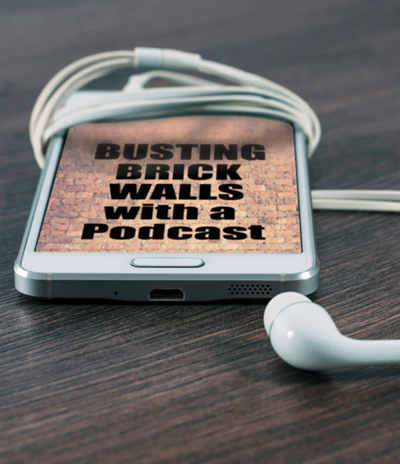
Busting Genealogy Brick Walls
But can a podcast help you bust a genealogical brick wall? Well, according to listener and Genealogy Gems Premium member Natalie Zett, you bet they can! With Natalie’s permission I want to share her email with you today because I believe it will not only inspire you, but it also provides an excellent example of how to apply what you hear.
“Hi Lisa Louise and the Genealogy Gems Gang –
As a long-time listener and Premium Subscriber, I recently put everything I’ve learned from you to the test!
I’ve traced most of my direct ancestors back to the 1500s–and have a fairly complete family tree. So, I figured that there weren’t any BIG things left to discover.
Then, a few months ago, I searched my father’s surname, “Zett,” among my Ancestry.com (DNA) matches, fully expecting to see family members that I already knew. I wanted to know if they had photos or other records that I didn’t have so I could stay current.
I saw the list of usual suspects (cousins that I’d grown up with), but also saw a handful of new 4th cousin matches who had the surname Zett in their family trees. I had no idea who any of these matches were!
A closer look revealed that those matches with family trees shared a common ancestor: “Caroline Zett,” who was born “in Hungary” around 1859 and died in Syracuse, New York around 1899.
The records for Caroline were scant–besides the family tree listings, there were only a few census entries, and marriage certificates for her children. Initially I thought she married into our family, but it appeared that Zett was her birth name. “Caroline” however is not a name I would expect to see.
My Zett ancestors are Carpatho-Rusyns, an ethnic minority from the part of the former Austro-Hungarian Empire that is now Eastern Slovakia.
Our surname was “Zid” in Slovak or “Zsid” in Hungarian, but in terms of first names, there wasn’t much variation.
My direct-line female ancestors were: Maria, Anna, and Elizabeta. Within their nuclear families, names were often recycled. For example, if a girl called Maria died and another girl was born later, she might also be named Maria –this made family tree work a lot of fun! So, “Caroline” didn’t fit into that naming tradition–and, to my ears, didn’t sound Slavic.
Caroline’s husband was called John Frisco, which also didn’t sound very Slavic (the Frisco’s I knew were all Italian). Marrying outside of one’s ethnic group in the 1880s would have been unusual, so that also was a puzzle.
And Syracuse, New York was also perplexing. My grandparents on both sides immigrated from Eastern Europe to Johnstown, PA, and those who did branch out, moved westward. I knew of no one in the family who settled in New York.
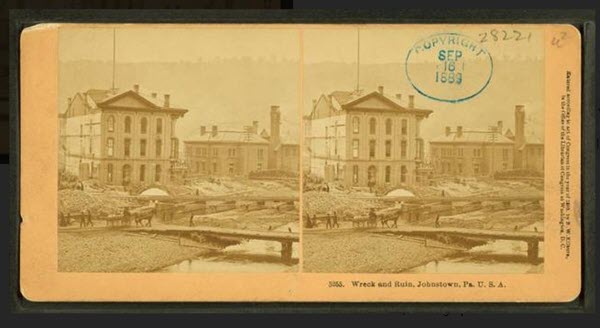
Famous for a flood: “Wreck and Ruin, Johnstown, PA U.S.A.” Kilburn Brothers, Photographer (Public Domain)
What was going on here? The brick wall I was hoping to scale was turning into genealogical quicksand!”
WWLLD Leads to 4 Actionable Steps
“So, in the spirit of WWLLD (“What Would Lisa Louise Do?”), I countered that confusion with the following actions!!
1. Created a private family tree on Ancestry for Caroline (Editor’s note: an idea discussed in episode #229) and her descendants and conducted records searches, which provided clues:
-
-
Two of Caroline’s children were listed as being born in “Hungary” which is something I’ve often seen in my early research (for years, I thought I was Hungarian!)
-
Another child was born in Johnstown in 1888. Besides the Johnstown connection, this was significant since my great-grandparents briefly lived in Johnstown during that same time period before returning to Slovakia.
-
The obituary of another child mentioned that she was buried in a Greek Catholic cemetery in Syracuse. This was also significant since, at that time, Rusyns were usually members of the Byzantine (Greek Catholic) church.
2. Used triangulation to validate that all of these “Caroline” matches belonged to my paternal grandfather’s family.
3. Reached out to the DNA matches (heard from just one person who had no information about Caroline).
4. Also used Ancestry’s “Predicted relationship” tool, which showed that these matches and I shared the same gr-gr-great grandparents.
All signs pointed to Caroline being the sister of my paternal great-grandfather, Andreas. But the records for my great-grandfather’s siblings listed Maria, Anna, Anna, Anna, Anna, Elizabeta, George, and Adam. (Yes, there were four different Anna’s among those siblings!). No Caroline to be found there.
I took a closer look at those records though and found that Elizabeta was born the same year as “Caroline” (1859) and later married Joannes Fecko (which sounds somewhat like John Frisco). This is where my intuition kicked in and said I’d found them!
Still, I wanted to be sure, and consulted with a cousin who’s an expert on our Rusyn ancestors. Having traveled back and forth to our ancestral home village, Olsavica, Slovakia many times, cousin Dave has collected lots of records throughout the years. (Most of these records are unavailable online).
Dave reviewed these records against my research and found the marriage for Elizabeta and Joannes. He further found the birth records for two children who were born in Olsavica. The names and birthdates of these children exactly matched the records for the children I’d located.
He concluded that Elizabeta and Joannes immigrated to America in the late 1880s and would have been among the first immigrants from Olsavica to venture to the USA.
He further theorized that, after my great-grandparents returned to Olsavica, Elizabeta and Joannes may have decided to adapt to America ways quicker than they would have otherwise to survive, thus adopting names that (to them) sounded more American.
So, Elizabeta became Caroline and similarly, her husband, Joannes Fecko, became John Frisco! Also, since Elizabeta and Joannes were living in Johnstown during the great flood of 1889, that might have inspired them to relocate to Syracuse.
I can only say WHEW!
This is the first time I’ve run into this type of name switching in my ancestral research!
In tandem, I wonder if any living Frisco cousins grew up thinking they had Italian ancestry –and are puzzled as to why this isn’t showing up in their Ancestry DNA results!
Should I ever establish/reestablish contact with any of them, I’m sure they’ll be surprised as well!
I didn’t realize how much knowledge I’d absorbed (actively or even passively) from listening to your podcasts, watching your videos, and reading your articles. But whenever I hit a roadblock, I always had another tool I could pull out, e.g., Hit a dead-end with records? No problem, just study the DNA matches (editor’s note: as we discuss in many Premium videos and podcast episodes like Episode #197.) When that stops working, look at newspapers and Google Books! I had it covered!
(Editor’s note: Here’s a listing of all our articles on Newspaper research. Genealogy Gems Premium eLearning members can watch the full length video class Google Books: The Tool You Should Use Every Day here.)
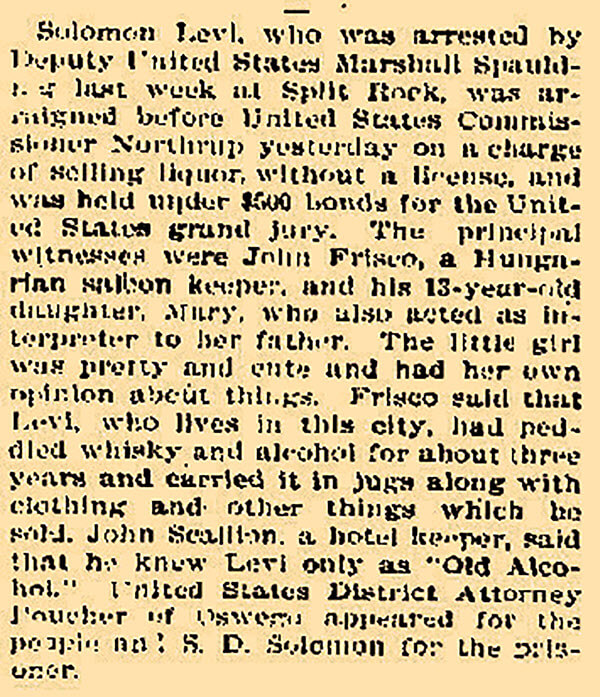
Newspaper found! “Solomon Levi, who was arrested by Deputy United States Marshall Spaulding last week at Split Rock, was arraigned before United States Commissioner Northrup yesterday on a charge of selling liquor without a license, and was held under $500 bonds for the United States grand jury. The principal witnesses were John Frisco, a Hungarian saloon keeper, and his 13-year-old daughter, Mary, who also acted as interpreter to her father. The little girl was pretty and cute and her had own opinion about things. Frisco said that Levi, who lives in this city, had peddled whiskey and alcohol for about three years and carried it in jugs along with clothing and other things which he sold. John Scallion, a hotel keeper, said that he knew Levi as “Old Alcohol,” United States District Attorney (illegible) of Oswego appeared for the people as: S.D. Solon for the (illegible).” January 16, 1896. The Syracuse Standard.
Although I didn’t get this written until (now), rest assured that I thought of each of you at Genealogy Gems and was so grateful!
Thank you for helping me place my Great-Aunt, Elizabeta/Caroline and her descendants in their rightful place in our family tree!! It’s quite a story and I couldn’t have cracked that wall without you.
Thanks for the continual inspiration. I swear my IQ has gone up several points since I began listening to GG!
With gratitude, Natalie Zett”
Share Your Story
Reading the challenges faced and strategies used by other researchers can help to reinvigorate our own genealogical search. Thank you to Natalie for taking the time to write and for providing permission to share her story.
Have you made an exciting discovery thanks to something you heard on the Genealogy Gems Podcast? Please leave a comment below!
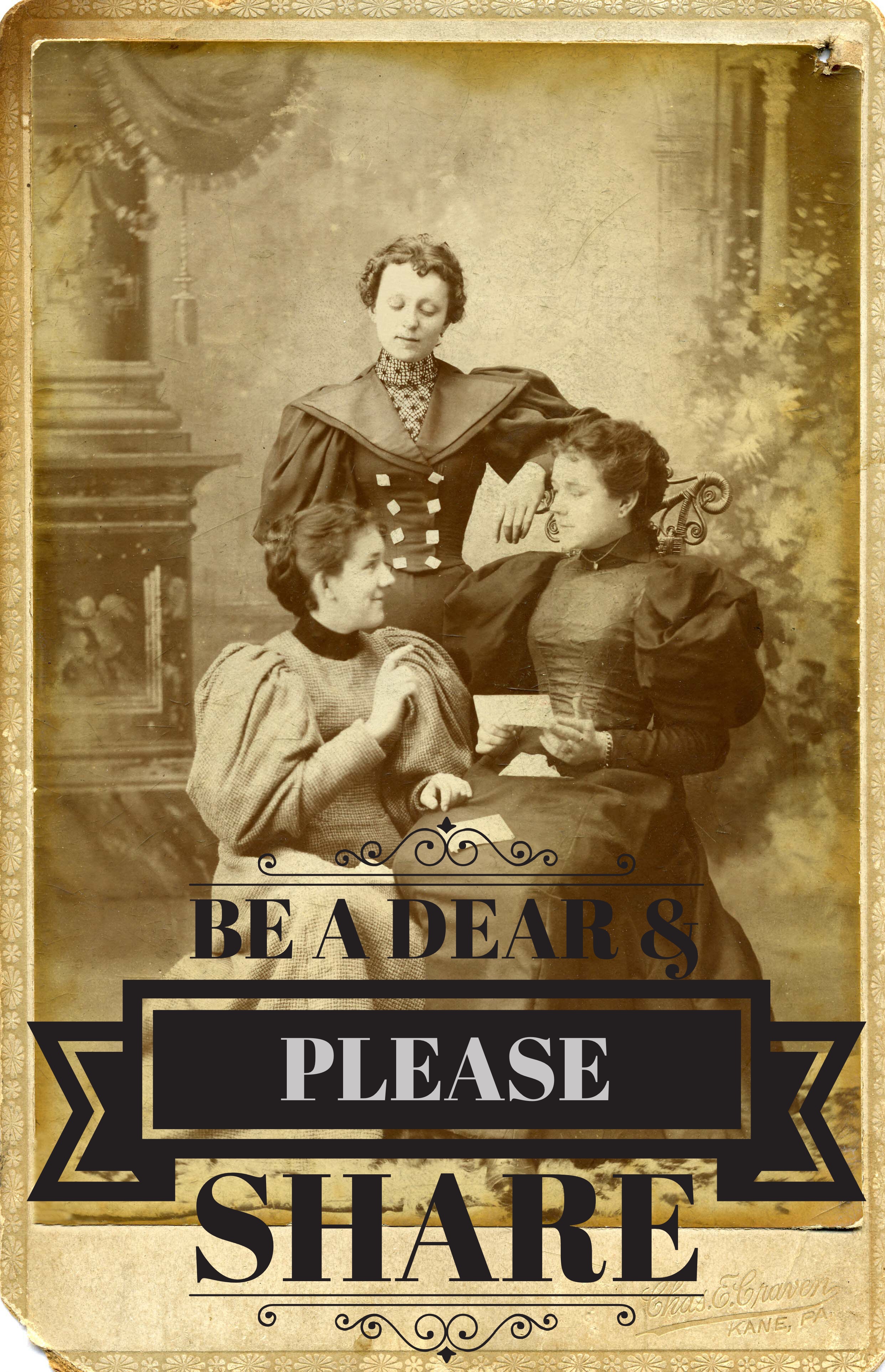
by Lisa Cooke | Oct 19, 2016 | 01 What's New, Court Records, Inspiration |
Researching court records may require some advanced genealogical skills, but the benefits are worth the effort. Lisa Louise Cooke helps a reader get out of a genealogical slump and makes the case for why you should be researching court records.
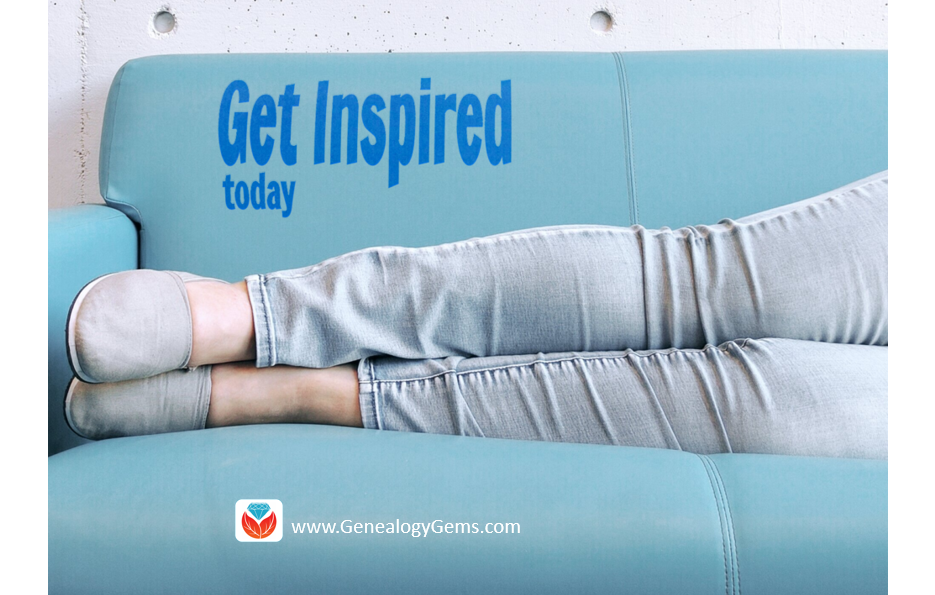
Our reader shared:
I have been doing my family tree on and off for about 10 years. Right now, I feel I’m in a slump. A couple of years ago, I started the NGS Home Study Course. I have only got up to lesson six. I feel obligated to finish all 16 lessons. I get motivated to do genealogy when I read various articles on it. However, I can’t get motivated to do the work. This has bothered me for a year. Do you have any suggestions on how to get back on track? I know court records seems like a big mountain for me. Thank you in advance for any suggestions.
We all definitely hit slumps. I have some ideas and some motivations for you, because you are not alone.
Getting Over the Slump
You mentioned that you “feel obligated.” In reading your email, I’m curious as to what your original motivation was to do the course. If it was to become a professional genealogist, my answer would be different than if this was for your personal improvement. If this was for your own personal improvement, then you have much more flexibility.
At one time, the NGS American Home Study Course gave you a very lengthy time to finish the course work. Now, the classes are offered virtually online. Because of this change, the Home Study Courses are currently divided into four segments. Within each of these segments, you have four classes, or assignments. You are given six months to complete these four classes within your specific segment. For those who need extra time, a one-time extension of three months is granted by contacting the NGS Course Administrator. Also with this change, you may feel a little more pressure to finish quickly.
Genealogy Gems Contributor Amie Tennant offers this advice:
“First of all…when I took the NGS Home Study Course, I got in a huge slump too! It took nearly 3 years for me to finally finish all the course work. One thing that helped (which helps me now with getting behind in my certification portfolio,) is a method I call “A record a day, keeps procrastination at bay.” When I get bored or unmotivated, it is usually because something has gotten difficult. Lessons 1-6 of the NGS class were really easy for me, but after that it got harder, especially when it was time to do the courthouse review exercise that encourages you to make a visit. Even if you can’t visit the courthouse, you can often find appropriate records online. By promising myself a smaller more attainable goal like finding one key record a day online, I could keep motivated. Eventually something clicks and you get that excitement again.
Lastly, when I was really struggling, I took a friend. We made a day of it with researching at the courthouse and then having a nice relaxing lunch. It was a great day!”
Like Amie, when I find myself unmotivated, it is usually because it’s not my burning interest at that time. If I’m doing genealogy for personal use, I don’t fight it. Life’s too short and genealogy should be fun and invigorating. Sometimes, we’re just not ready for a particular record type, and if it’s not bringing your research to a standstill, there isn’t as much motivation. For me, there’s nothing like revisiting the excitement of what is waiting to be found! I asked Genealogy Gems followers on Facebook to share the Court gems they have found, and I hope it fills you with renewed excitement and enthusiasm. But first, here are some ideas on how to research court records:
Researching Court Records – How to
To get the most from researching

Will records are always a great find when researching court records.
court records, here are four tips to keep in mind:
1. Call the courthouse first. Ask them when they are open, days and times, and if they close during the lunch hour. (Sometimes this information on their website is not up to date.)
2. Ask what records are available at that location and for what years. It would be awful to drive to a far off location, only to find the probate records you are interested in are now housed 5o miles away at another repository!
3. Take the following with you: paper, pencils, a camera or smartphone, small bills and coins, a bottle of water and small snack. Even though there may be rules preventing you from snapping a picture of the document you want, you never know. The money comes in handy if you have to pay for copies of the records you want. Also, you are likely going to be there for awhile, so having a little snack will keep you from thinking only about your empty stomach.
4. Make your visit to the courthouse when you are not in a hurry. Let your finds determine how long you stay. When you are pressed for time, you may inadvertently skip over an important find, so set the whole day aside.
Making the Case for Court Records – Inspiration!
I asked our readers “What Genealogy Gems have you found in court records?” Get ready to soak in their excitement!
Kathleen shared: “An ancestor in the 1840s was living in Mississippi and had a 2nd wife and children. Everyone always assumed that the 1st wife died. Nothing in any records ever indicated anything different. On a trip to Salt Lake City ten years ago, I was frustrated and hitting dead ends. I decided to pull a film for Lawrence County, Mississippi loose court papers. It was NOT indexed and I was just browsing out of curiosity. I found my ancestor in 1849 with eleven pages of hand written divorce papers! She accused him of mistreatment and moving a slave woman into their residence who had threatened her with a knife when she went to get money for her nine children!”
Brian shared: “My brick wall has been my 2nd great-grandfather, John B. Reese. I knew he died sometime before 19 Dec 1856, as that was the date his estate entered probate. On a recent research trip to Missouri, I visited the Bates County Historical Museum where Chris Wimsatt found an entry in the County Stray Book indicating that John B. had found a stray “strawberry rone [roan] 3 years old 14 hands 3 inches high” 24 May 1856. Woo hoo! Narrowed that death date right down!”
Helen shared: “Just solved a century old mystery in the basement of a courthouse in the insane books. What would now be called postpartum psychosis.”
Diane: “My mom had a wealthy Aunt Jenny; we have her silver, antiques, etc. She was married to a lawyer who became Chief Justice of the Rhode Island Supreme Court in the 1890s-1900s. I knew she was from a poor family and couldn’t imagine how they met. I found a hidden first marriage for her that my mom never knew about. When I got the divorce papers, turns out husband #2 had BEEN HER HUSBAND’S LAWYER. My mom almost fell over when I called her on the way home.”
Maria: “I also found a great uncle who ended up marrying a widow who was a millionaire from her late husband – she was old enough to be his mother & had step children older than him! Her life was in newspapers and court records! I found someone local to scan her succession & her late husband’s succession court documents to me. Fascinating stuff from the turn of the century to the 1930’s! It’s all public records! Also tracked down her great grandson; he sent me priceless photos. The kicker is after I found where the late husband was buried to document on Ancestry, the cemetery actually mailed ME a bill for grass cutting! – twice!”
Pat: “My great uncle came from Germany to wild West Denver 1860 and became a hard rock miner. How did I know? His court records regarding his death “found frozen to the floor in his mining cabin” shows what he owed at the time of death. Actual grocery list from Hancock Bros. Dry Goods Store where he bought (among other things) blasting powder, helped ID that he was hard rock rather than placer miner. Funeral info about how much it cost to dig his grave, use of team of horses, and a new set of clothes… Amazing. Find a Grave volunteer found the spot where he was buried WAY off the grid, off a side road. No headstone. Depression in grass x many feet from old fence. Volunteer contacted local historical society for me to find this on his own. Incredible. I wrote his story.”
More Gems on Researching Court Records
It seems many of us have had exciting breakthroughs researching court records. If you have had a triumph and would like to share, please let us know in the comments below. You can also read about even more inspiring ways to take your courthouse research to the next level in these articles below. Happy hunting!
4 Ways to Power Up Your Courthouse Research Skillls
Where to Look When There’s Been a Significant Record Loss

Discovering the History of Your House and Your Neighborhood
by Betsy Green
by Sally Light








